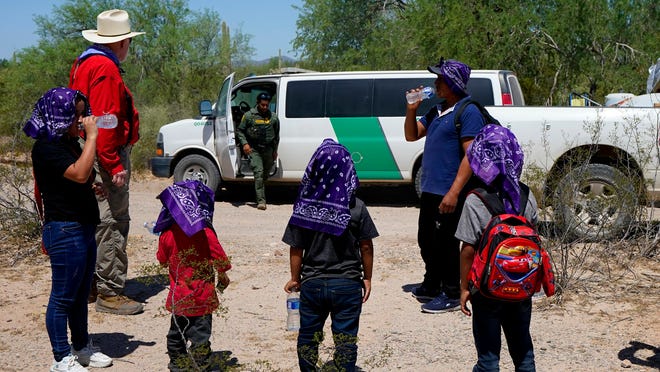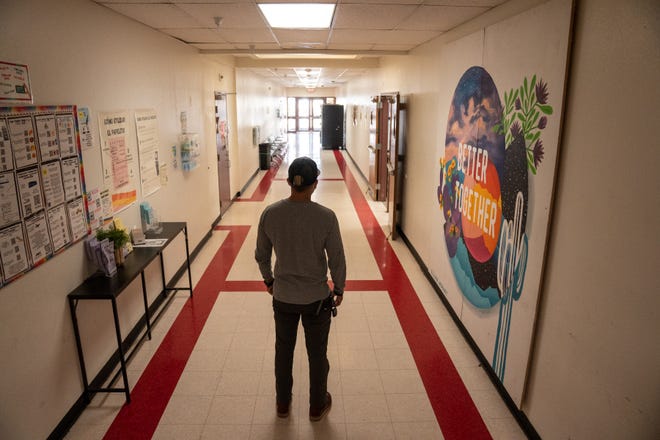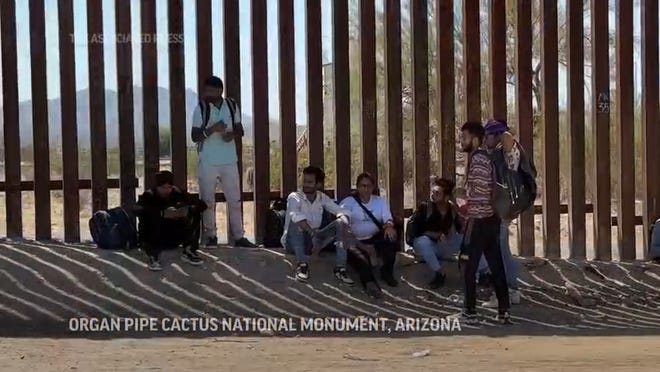
The U.S. Department of Homeland Security handed out another round of funding to humanitarian aid organizations helping migrants released at the U.S.-Mexico border. But the process the federal government uses is raising questions about how that money is distributed, particularly for nonprofits and local governments closer to the southern border.
DHS awarded more than $77 million to 54 local governments and nonprofits providing humanitarian assistance to migrants and asylum seekers released by federal border officials into the United States. That assistance includes housing, meals and transportation, among other things.
This is the second round of funding announced under a new federal program created to reimburse nonprofits and local governments for assistance to migrants called the Shelter and Services Program. It is administered under DHS’ Federal Emergency Management System.
Of the $77 million total FEMA announced in the second round of funding, nearly $56 million will go to local government and nonprofits in the four U.S. border states with Mexico. Arizona will receive $5.9 million.
What is the Shelter and Services Program?
The money and the establishment of the Shelter and Services Program comes from funds allocated by Congress through the 2023 Consolidated Appropriations Act amid elevated numbers of migrants and asylum seekers processed at the border and released into the interior of the country.
Local governments and nonprofits have stepped in to provide services in order to avoid having these migrants released into the streets or stranded in border communities.
Since 2019, Congress has been reimbursing nonprofits and local governments for humanitarian assistance through the Emergency Food and Shelter Program, which is intended to help families and individuals experiencing hunger and homelessness. Since that time, lawmakers have set aside more than one billion dollars for those efforts.
But some lawmakers, especially those in Arizona who worked to secure funding for border communities, have been increasingly critical of the way the new Shelter and Services Program allocates funding. Previously under the EFSP, the funding was limited almost entirely to communities along the U.S.-Mexico border. Under the SSP, nonprofits and local governments around the country are eligible to apply for the funds.
How is the money being distributed?
While the majority of the $77 million from the second round was awarded to border communities, cities and nonprofits in the interior of the country received the majority of $291 million awarded in the first round of funding from the SSP.
Arizona senators Kyrsten Sinema and Mark Kelly, who played key roles in securing funding for border communities since 2019, said the change failed to prioritize the work done on the frontlines in a letter they sent to DHS leadership.
“SSP has not been established to adequately meet the needs of border communities and the critical providers operating in the border environment,” their joint letter read. “The program is proving problematic and your agencies’ poor management is causing Arizona to lose vital partners in our border management network.”

Under the SSP, Arizona has received $29.8 million of the $368 million available this year. Meanwhile, the other three border states, California, New Mexico and Texas have received a combined total of $155.8 million. The remaining $182 million went to communities away from the U.S.-Mexico border. These cities tend to be the final destination for many of the migrants released at the border.
For example, New York City alone has received $106.8 million, more than any single border state. It has received more than 100,000 asylum seekers since April 2022, according to the mayor’s office, straining city resources and forcing hundreds of them to sleep in the streets waiting for shelter beds to open up.
However, Arizona lawmakers say the way DHS is distributing the funds through the SSP disadvantages communities in Arizona and elsewhere along the border on the frontline of the humanitarian response.
Arizona lawmakers have concerns
U.S. Rep. Raul Gallego also sent out two letters, one to FEMA and another to Homeland Security Sec. Alejandro Mayorkas, also outlining his concerns with the change. The main one is that because Arizona border communities are getting a smaller share of the funding, the nonprofits and local governments could run out of money early next year to continue their coordinated response.

“As you and other high-ranking officials have seen for yourselves in visits to the state, the regional approach known as the ‘Arizona model’ has been uniquely effective, and made Arizona the only border state with zero street releases last year. These new funding decisions threaten the ability to maintain the Arizona model,” Gallego’s letter said.
Gallego and Sinema and Kelly sent their respective letters before FEMA awarded the second round of funding on August 21. The department has not responded to them yet, according to their offices.
Sinema told The Arizona Republic in a statement that she was glad to see border communities get a greater share of federal resources in the latest round of funding, but said the amount Arizona received was still too low.
“Arizona communities bear the brunt of the border crisis and are forced to do more with less as the Tucson sector consistently sees higher numbers of migrant crossings,” her statement read. “It’s time the administration provides Arizona the resources we need to secure the border, keep our state safe, and ensure the fair and humane treatment of migrants.”
In the two letters, the three lawmakers also outlined additional concerns with the funding formulas under the SSP, including “arbitrary” spending caps on noncongregate shelters such as hotel rooms. They also demanded greater communication and clarity from FEMA to the nonprofits and local governments.
- Arizona received $23.9 million in the first round of funding under SSP. In the second round, they got $5.9 million.
- NM 1st: $11.9m, NM 2nd: $2.78m
- CA 1st: $31.7m, CA 2nd: $14.7m
- TX 1st: $62.5m, TX 2nd: $32.2m






